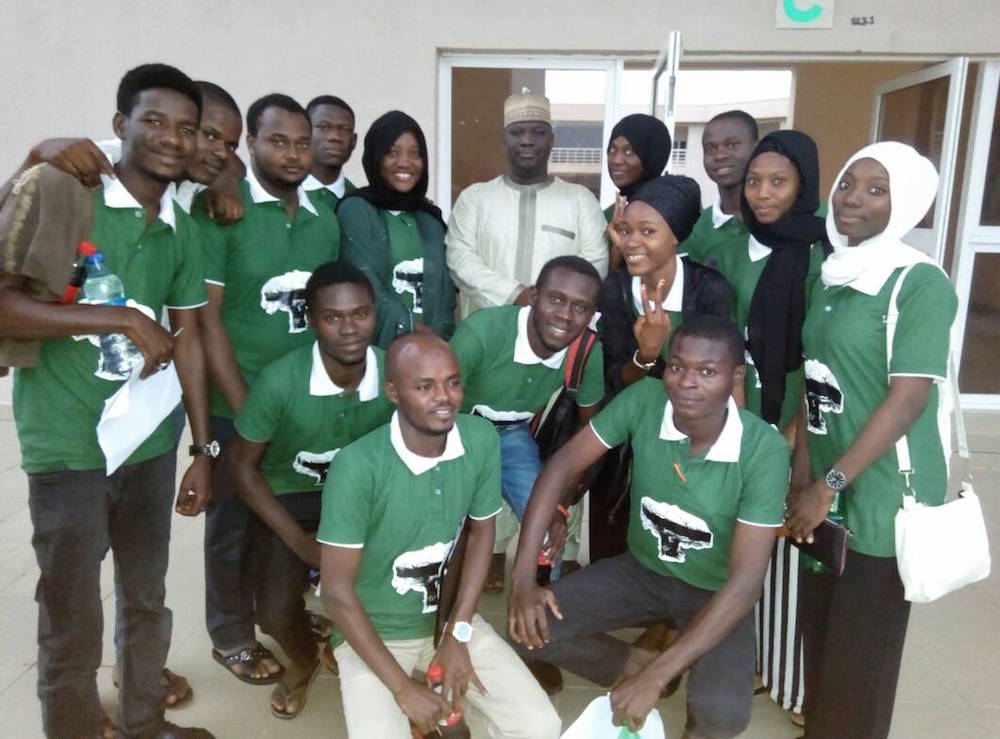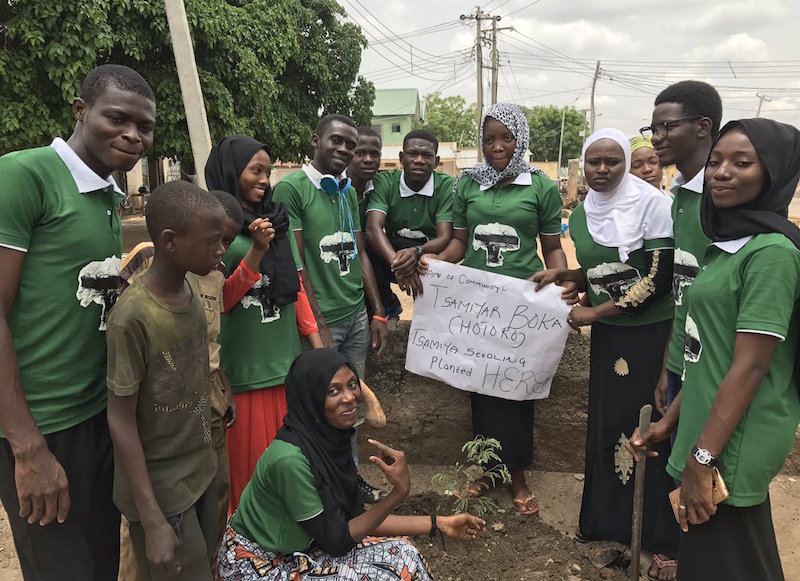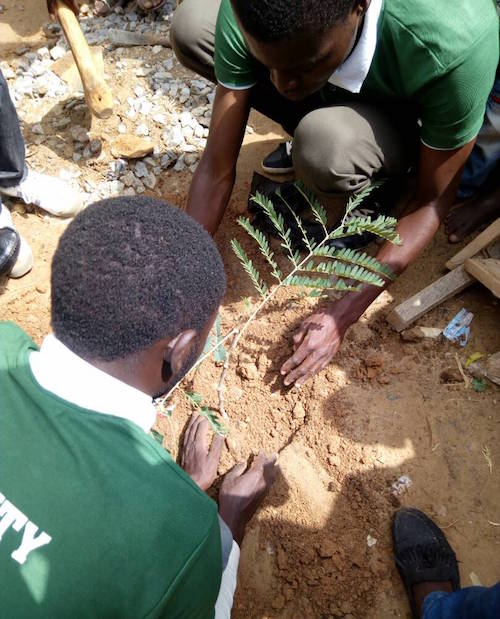Spotlight on SDG Labs: Trees grow in Kano
This is the first in a series of stories that focus on the SDG Labs, a group of prototype projects supported by Future Earth and Stockholm Resilience Centre. Stay tuned for features on more of these labs in the weeks ahead.
To take part in the ICSS 2017 conference online, see a list of resources here.
To learn about a project in Fiji, read Indigenous knowledge for healthy islands.
To read about sustainability in the craft beer industry, read Brewing up sustainability.
You can follow the MR CITY Lab on Twitter.
This August, 20 young men and women from Kano, Nigeria, traveled across the city on a mission to plant trees. These Millennials – a mix of university students and non-students – brought plants to every part of Kano, including rich and poor areas, a police station and even the home of a senator. In all, they planted more than 250 trees in the span of two days, says Aliyu Salisu Barau, who heads the Department of Urban and Regional Planning at Bayero University Kano.
The effort was part of a project that Barau initiated this year called the Millennials and Resilience: City, Innovation and Transformation of Youths Laboratory, or the MR CITY Lab. It is one of more than 22 SDG Labs that will be showcased at the upcoming 7th International Conference on Sustainability Science (ICSS 2017) in Stockholm, Sweden. These labs, which are supported by Future Earth, Stockholm Resilience Centre and The University of Tokyo Integrated Research System for Sustainability Science (IR3s), seek to “generate prototype solutions to complex problems.” In particular, the labs promote creative ways of addressing the United Nations’ 17 Sustainable Development Goals (SDGs) – a set of international targets for making the world more sustainable and equitable.
Barau’s idea was to restore green spaces and native plants to Kano, Nigeria’s second largest city, and to do it by tapping the skills and enthusiasm of the city’s Millennial residents. This age bracket includes men and women born roughly in the early 1980s to early 2000s. He says the project shows that young people can, and should, be major players in making Nigeria more sustainable.

Members of the MR CITY Lab team pose for a photo after a one-day "hackathon" in August. Photo: MR CITY Lab
“The future belongs to these people,” says Barau, who will talk about the project during ICSS 2017, which runs from 24 to 26 August. “If we think about innovative ideas to transform the world and support resilience and sustainability, then the only option is to engage the youth and put them at the front.”
Population pyramid
That’s important in Nigeria where, like much of the developing world, young people make up the bulk of the population. More than two-thirds of Nigerians are below the age of 30 – what researchers call a “population pyramid.” But that doesn’t mean that these youths have a say in how the country is run, Barau says.
“Those at the top rarely think about them,” Barau says. “They are not given opportunities to say who they are and what they care about.”
He launched the MR CITY Lab to give Kano’s young people a role in helping to improve life in the city – a key component of Sustainable Development Goal 11, which focuses on urban areas. Barau began by recruiting several university students, who brought in other Millennials, in part by using the social media platform WhatsApp.
The group started off by watching film footage of Kano that had been shot by a documentary crew from the United States in the 1950s. What was remarkable about the footage were the trees: At the time, the city was full of native plant species like silk-cotton trees (Ceiba pentandra) and baobabs (Adansonia digitate).
Barau explains that Kano had been a green city for hundreds of years. In the 16th Century, almost two-thirds of the city, then the third largest population centre in Africa, was made up of open spaces. That changed in the 1980s when rapid urbanisation pushed buildings into those green areas – to the detriment of the city’s poor and youth, he says. Years ago, a visitor to Kano might see hundreds of young people riding horses around the city’s open spaces on weekends. Today, that pastime is disappearing.
“Young people in those areas cannot even mention the names of those trees,” Barau says. “They don’t know them.”

MR CITY Lab team members plant a Tamarindus indica sapling in the Tsamiyar Boka neighborhood, named after that same species of tree. Photo: MR CITY Lab
Zahra Y. Z Ya’u, the coordinator of the MR CITY Lab and a graduate student in urban and regional planning at Abubakar Tafawa Balewa University in Bauchi, Nigeria, agrees. “If you look at the video, you can’t say that this was Kano,” says Ya’u, who grew up in the city. “If you take the image of Kano today, what you see is roofing everywhere.”
To change that image, she and the other Millennials on the project led a day-long hackathon, a type of event that encourages problem-solving. The young people decided to focus on 20 areas that are symbolically important to the city – communities that had been named after native tree species that are now uncommon in Kano. They included Tsamiyar Boka, which got its name from the legume-bearing species Tamarindus indica, and Durimin Iya, named after the fig tree Ficus polita. Then came the heavy lifting: In a two-day blitz, the team planted more than a dozen trees in each of the 20 areas.
“They worked day and night to plant those trees,” Ya’u says. “I was the one telling them, it’s now 10 p.m. We have to go home.”
Local engagement

Two young men plant a tree belonging to the species Parkia clapatoniana in Kano's Dorayi community. Photo: MR CITY Lab
But the project couldn’t have succeeded without the involvement of local communities, she adds. Before they began planting, the hackathon team members met with local leaders around the city to talk about the project and why trees are so important for Kano.
The engagement paid off: Thanks to coverage of the project by several local radio programmes, residents of the 20 communities came out to welcome team members. One police station that focuses on sexual offenses and child trafficking reached out to the group to ask for its own trees. It was a major achievement in a city where people rarely plant trees in public spaces.
“Many people were waiting for us to come and get the trees, especially the children who said, ‘I want this tree to grow with me,’” Ya’u says.
Motivated by that enthusiasm, she and her fellow Millennials want to continue the MR CITY Lab, expanding it into an effort than can plant more trees and raise more awareness.
For his part, Aliyu Salisu Barau says that the project shows what young people can achieve if they’re given a chance. “They are full of energy,” he says. “Just integrate them. Let them know what they will do. Let them know why they will do that, and I assure you, you will see great success."
DATE
August 23, 2017AUTHOR
Daniel StrainSHARE WITH YOUR NETWORK
RELATED POSTS
Spotlight on LMICs – Tired of Breathing in Pollutants? Time for Better Fuel Economy and Vehicle Standards
Future Earth Taipei Holds 2024 Annual Symposium
Spotlight on LMICs – The Future’s Juggernaut: Positioning Research as Anchors for Environmental Health